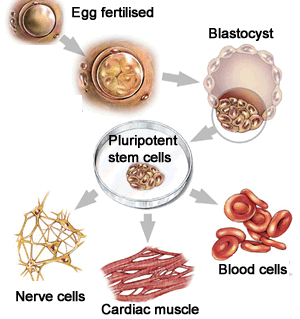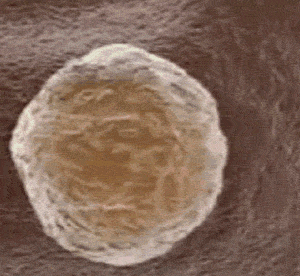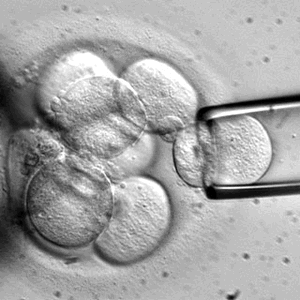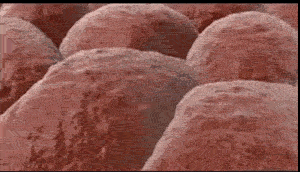Stem cell research
The human body has about 300 trillion cells, most of which perform completely specialised functions. Red blood cells, nerve cells and muscle cells, just to name a few, are all wonderfully specialised for what they do. These cells cannot do anything other than what they were designed for. Nerve cells for example specialise in conducting and propagating electrical signals, while muscle cells contract and red blood cells transport oxygen.
Stem cells, however, do not have a specialised function, they are an immature kind of cell that still has the potential to develop into a specialised cell, as shown on the right.


There are generally 3 types of stem cells that are important:
- embryonic stem cells
- adult stem cells
- umbilical cord stem cells

Adult stem cells exist in mature organs and supply the organs with replacement cells throughout the life of the person. Until recently, only tissues that replace themselves at a great rate, like blood and skin, were thought to have stem cells. Now, researchers are finding stems cells in all body tissues even the ones that do not appear to be good at replacing damaged cells, such as the brain, heart and pancreas.
The animation on the right shows stem cells differentiating into heart muscle cells.
Cultivation of such stem cells may offer a cure for diabetes, Alzheimer's and heart conditions.
Compared to embryonic stem cells, which can make replacement cells for any tissue, adult stem cells are normally dedicated to making the cells for the particular tissue they are found in. Adult stem cells found in the skin, for example, can only develop into skin cell and unlike embryonic stem cells they do not divide indefinitely.

Blood can be collected from the umbilical cord of a newborn baby shortly after birth. This blood is rich in cord blood stem cells that can be used to generate blood cells and cells of the immune system.
Umbilical cord stem cells can thus be used to treat a range of blood disorders, such as leukaemia and sickle cell anaemia.

Umbilical cord blood can be stored in a special blood bank for use as a potential source of transplant tissue for the baby matures. As this blood originated from the person receiving it, there would be no problem with rejection of the transplanted tissue.
Alternatively, the umbilical cord blood of one individual may be donated to a general cord blood bank for use by other people with similar tissue types in need of a transplant, thus minimising complications associated with rejection.
Describe the difference between stems cells and other cells in the body.
What are the three main type of stem cells found in the body and how do they differ from each other?
What is meant by the term pluripotent? Give an example
How are multipotent cells different from pluripotent cells?